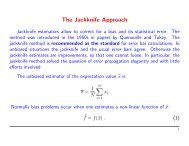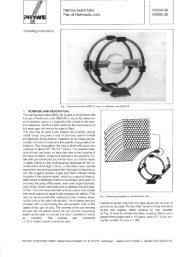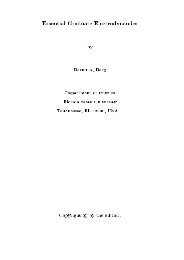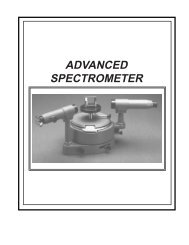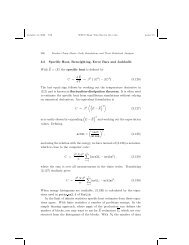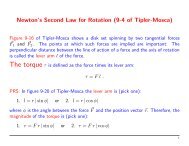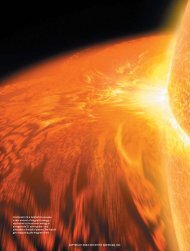MICROWAVE OPTICS - Granular Materials Laboratory
MICROWAVE OPTICS - Granular Materials Laboratory
MICROWAVE OPTICS - Granular Materials Laboratory
You also want an ePaper? Increase the reach of your titles
YUMPU automatically turns print PDFs into web optimized ePapers that Google loves.
Microwave Optics012-04630F5While watching the meter, slide the Probe along the Goniometer arm until the Probehas passed through at least 10 antinodes and returned to a node. Record the newposition of the Probe and the number of antinodes that were traversed.Antinodes Traversed= __________________________.Final Probe Position = _________________________.6 Use your data to calculate l, the wavelength of the microwave radiation.l =_________________________.7 Repeat your measurements and recalculate l.Initial Probe Position =_________________________.Antinodes Traversed =_________________________.Final Probe Position =_________________________.l =_________________________.Questions1 Use the relationship velocity = ln to calculate the frequency of the microwave signal(assuming velocity of propagation in air is 3x10 8 m/sec).(n = the expected frequency of the microwave radiation -10.525 GHz).Method B1 Set up the equipment as shown in Figure 3.2. Adjust the Receiver controls to get afull-scale meter reading with the Transmitter and Receiver as close together as possible.Slowly move the Receiver along the Goniometer arm, away from the Transmitter.How does this motion effect the meter reading?The microwave horns are not perfect collectors of microwave radiation. Instead, theyact as partial reflectors, so that the radiation from the Transmitter reflects back andforth between the Transmitter and Reflector horns, diminishing in amplitude at eachpass. However, if the distance between the Transmitter and Receiver diodes is equalto nl/2, (where n is an integer and l is the wavelength of the radiation) then all themultiply-reflected waves entering the Receiver horn will be in phase with the primarytransmitted wave. When this occurs, the meter reading will be a maximum. (Thedistance between adjacent positions in order to see a maximum is therefore l/2.)2 Slide the Receiver one or two centimetersalong the Goniometer arm to obtaina maximum meter reading.Record the Receiver position along themetric scale of the Goniometer arm.Initial Position of Receiver =_________________________.14Figure 3.2 Equipment Setup



